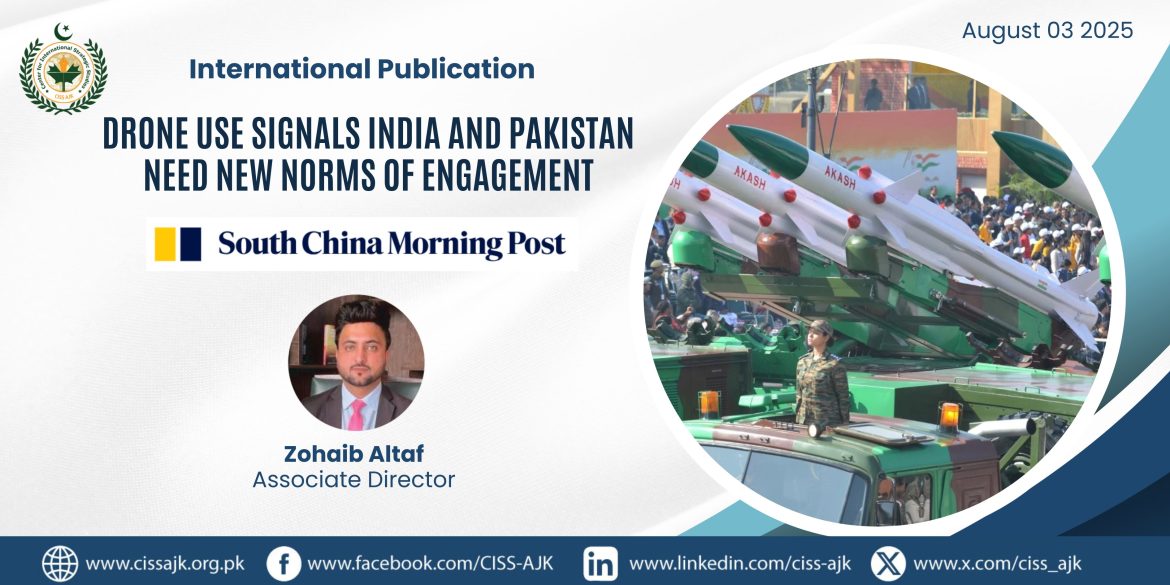Clearly defined red lines regarding the use of proxies and low-cost precision systems against strategic assets are required
On July 21, reports confirmed that militant groups in Pakistan have begun using small quadcopter drones to target security forces. While this may appear to be a mere tactical shift, it reflects a deeper and more alarming transformation in South Asia’s strategic arena. The growing convergence of non-state actors, emerging technologies and external enablers is eroding traditional conflict thresholds and obscuring accountability.
Pakistan faces a similar trajectory of threats. In April, security officials said they had uncovered a terror plot to attack Masroor Airbase, one of the country’s most sensitive military sites. Such an attack would not be unprecedented. Witnesses to a 2011 attack on Mehran Naval Base said militants destroyed P-3C Orion aircraft essential for anti-submarine warfare and maritime surveillance. The 2012 attack on Minhas Airbase in Karma resulted in damage to early warning defences.
Such attacks, previously conducted through militant infiltration, now risk being supplemented or replaced by drone-based incursions launched from within Pakistan’s territory or border regions. The complexity is further deepened by India’s evolving approach to covert operations.
Since 2021, Indian intelligence services have reportedly orchestrated a campaign of targeted assassinations inside Pakistan using Pakistani and Afghan nationals rather than Indian operatives. These operations, conducted with the help of intermediaries in the United Arab Emirates, indicate efforts to establish deniable operation channels. Similar tactics have reportedly been applied in Canada.
Allied intelligence platforms and field assets further increase risks. India’s growing strategic footprint in Afghanistan and its engagement with Central Asian states such as Tajikistan create plausible pathways for smuggling drone components and dual-use systems into Afghanistan and then into Pakistan.
The doctrinal context adds a new layer of urgency. Indian naval captain Shiv Kumar, a defence attache based in Indonesia, remarked that Pakistan’s downing of Indian warplanes was “only because of the constraint given by the political leadership to not attack the military establishment or their air defences”.
“After the loss, we changed our tactics and we went for the military installations,” Kumar said, adding that India “first achieved suppression of enemy air defences and then that’s why all our attacks could easily go through using BrahMos missiles”. This sheds light on India’s emerging military doctrine, which appears to favour limited conventional strikes on high-value targets, including strategic infrastructure, under a calculated risk threshold. The strategy also emphasises the suppression of enemy air defences.
India’s expanding technological base fits this strategy. The country is developing intercontinental ballistic missiles that can be delivered by multiple independently targetable re-entry vehicles (MIRVs). It’s also working on hypersonic BrahMos variants, Israeli-origin systems like Rampage and Crystal Maze-II, and a suite of loitering munitions, including kamikaze drones.
Meanwhile, Pakistan has taken steps to adapt its use of air assets, backed by its existing weapons arsenal. The country has conducted military aircraft manoeuvres on non-traditional landing strips like motorways.
This convergence of militant rhetoric with heightened interstate tensions reflects a dangerous overlap between internal instability and external confrontation. When paired with drone technology or covert action, such threats reduce warning times and strain Pakistan’s already limited strategic depth.
The problem is not just operational, but structural. Blurred lines of responsibility, the co-mingling of strategic and sub-conventional tools and compressed response times undermine basic assumptions about deterrence and escalation control.
A drone strike on nuclear facilities carried out by a proxy but supported or tolerated by a state actor could trigger misperceptions of a decapitating first move. In such a scenario, de-escalation would be difficult, especially in the absence of crisis protocols or backchannels.
The need for a mutually recognised norm is pressing. India and Pakistan must agree either through formal channels or quiet diplomacy that strategic military infrastructure linked to nuclear forces or early warning systems is off-limits to proxy attacks and deniable sabotage. In an era where disruption no longer requires a ballistic missile but merely a US$1,000 drone and a cellphone signal, such a norm is not a luxury but a strategic necessity.
Without this understanding, South Asia risks entering a phase of instability where responsibility is uncertain, intentions are misread and and escalation occurs faster than leaders can respond. Technology has changed the tools of conflict. It’s up to the region’s leaders to ensure it does not change the thresholds of war.



